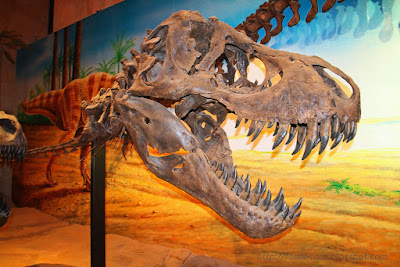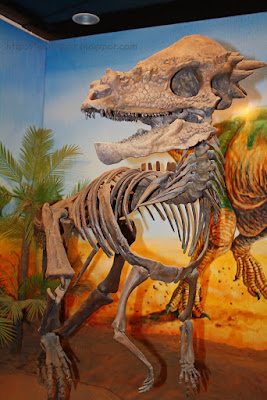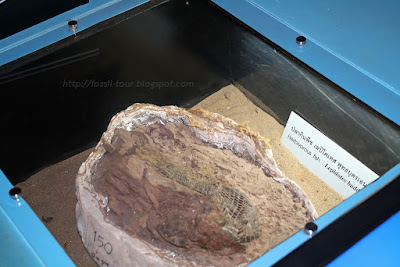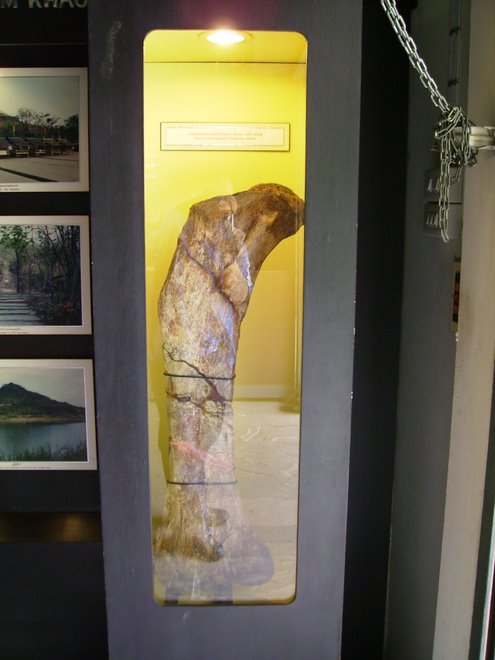Phu Kum Khao Dinosaur Excavation Site Museum
the most interesting excavation site of dinosaur fossils in Thailand. Numerous fossils were found in rock layers. Sahatsakhan county in Kalasin province (519 km Northeast of Bangkok).
Phu Wiang Dinosaur Museum (Khonkaen Province)
is a geological museum mainly exhibiting fossils. Phu Wiang Dinosaur Museum situated in the Khok Sanambin public area in Tambon Nai Muang, Wiang Kao district, Khon Kaen province in the northeastern region of Thailand.
Old Shell Fossil Museum 150 Millian Years
The museum features fossils of shells from the Jurassic period, dating to 140-150 million years ago. In the nearby area, 60 dinosaur fossils can be seen in the layer of siltstone, above the layer where the fossils of shells and ancient crocodiles are found.
Tuesday, July 21, 2015
Sirindhorn Museum Dinosaur and Human History
10:07 PM
Dinosaur Thailand, Dinosaurs Fossil, Kalasin Province, Phu Kum Khao, Phu kum khao Dinosaur Museum, Sirindhorn Museum
1 comment
Origin Dinosaurs
When Dinosaurs Conquered the World
The Reign of Dinosaurs
Coelacanth Axelrodichthys araripensis
Locality Brazil
Cervical vertebra of Siamosaurus suteethrni
Locality Ban Samran, Khon Kaen Province, Thailand
Teeth of Siamosaurus suteethorni
Locality Phu Kum Khao, Kalasin Province, Thailand
Dorsal vertebra of Siamosaurus suteethorni
Locality Ban Samran, Khon Kaen Province, Thailand
Homo sapiens 200,000 years ago - present
Homo neanderthalensis 600,000 - 30,000 years ago
Homo erectus 1.8 million - 200,000 years ago
Australopithecus africanus 3 - 2.3 million years ago
Sahelanthropus tchadensis 7 - 6 million years ago
Higher Primates (Anthropoids)
Australopithecus afarensis "Lucy"
Dated to 3.18 million years ago
Discovered in the Afar Desert of Ethipia in 1974, this first Australopithecus afarensis skeleton ever found was nicknamed "Lucy" after the Beatles'song "Lucy in the Sky with Diamonds".
Finds comprise bone fragments that make up about 40 percent of the total skeleton showing that she was about 1.1 m tall. Erupted wisdom teeth (third molars) in the jaw place her age at early twenties at the time of death. The shape of the hip bone indicates that she was female and could walk upright, which proves that human ancestors were bipedal long before they knew how to make stone tools.
Acheulean stone tools, Mousterian Stone Tools
Dinosaur History & Dinosaur Model | Phu Kum Khao Dinosaur Museum
12:54 AM
Dinosaur Park, Dinosaur Thailand, Kalasin Province, Museum, Phu Kum Khao, Phu kum khao Dinosaur Museum, Sirindhorn Museum
1 comment
Dinosaur Model @ Phu Kum Khao Dinosaur Museum
Northeastern Thailand During Mesozoic Era
During the early Mesozoic Era, Triassic, the northeastern part of Thailand had been covered by sea and consequently was uplifted forming mountains and volcanoes. However, many areas were subsided forming alluvial plains and fertile lakes. These lakes were full of algae, fishes, turtles and reptiles. Dinosaurs, prosauropod and sauropod, began to appear, the earliest sauropod was Isanosaurus attavipatchi.
In Jurassic, the climate was hot and dry but many regions of northeastern Thailand were still alluvial plains and swamps which were full of bivalves, fish the Lepidotes buddhabutrensis, crocodile the Sunosuchus thailandicus and dinosaur that began to evolve and increase in population such as sauropod, carnosaur, hypsilophodon and stegosaur.
During Late Jurassic to Early Cretaceous, northeastern Thailand became an extensive alluvial plain in which hundreds of rivers from Vietnam, Laos and Cambodia joined in the middle before flowing to the sea further in the west. There were several kinds of dinosaurs, Phuwianggosaurus sirindhornae, Siamotyrannus isanensis, Compsognathus, Kinareemimus etc, and later evolved to be Iguanodon and Psittacosaurus sattayaraki.
During the Late of Early Cretaceous, the Dong Phaya Yen mountain range was formed creating 2 landlocked basins, Nakhon Thai and Maha Sarakham, The basins consisted of extreme salty water from which potash and rock salt deposits formed. Consequently. the areas turned into dry land. Some of them were deserts. The dinosaurs might have become extinct either prior to the dry land stage or during the desert forming stage.
Dromaeosaurus sp.
Meaning - Running reptile, swift reptile
Order - Saurischia
Suborder - Theropoda
Family - Dromaeosauridae
Age - Late Cretaceous, 76 million years ago
Length - 2 m
Diet - animals, carrion
Locality - U.S.A. (Montana) and Canada (Alberta)
A herd of carnivorous dinosaurs
Dromaeosaur was a group of small-sized carnivorous dinosaurs with a big skull and eyes. Agile and fast running, it had robust legs, front claws and sickle-shaped hind claws. It overcame its prey by kicking, goring and leaving big wounds on the prey's body which died after losing blood. They might have travelled in herds helping each other hunt.
The dinosaurs in Dromaeosaur family were Dromaeosaurus, Deinonychus and Velociraptor.
Cenozoic Era
The Cenozoic Era or new era ranges from 65 million years ago until today and is divided into Paleogene and Neogene Periods.
Paleogene Period (65-23 million years)
There were 2 significant events during this period. The first one was the changing of climate from semiarid to arid. This resulted in transformation of tropical rainforest into grassland due to the cold current around Antarctica. It was formed during the separation of the Australian continent from the South American continent, creating ice sheet deposite on Antarctica. Another event was the dramatic increase of mammals which generated their diversity and they occupied the land, sea and sky. They were both carnivorous and herbivorous.This period is divided into Paleocene, Eocene and Oligocene
Neogene Period (23 million years - present)
This is the period towards the world of today. During the beginning of the period, all continents moved to their present position and the climate continuously cooled down. This resulted in the alternative ice age and warmer climate. The ancient mammals became extinct. Human ancestors started to evolve during the middle of the period prior to dissemination of their lineages.
This period is divided into Miocene, Pliocene, Pleistocene and Holocene.
Monday, July 20, 2015
Phu Nam Jun | Primitive Fish Site 150 million years ago
9:45 PM
Dinosaur Thailand, Kalasin Province, Lepidotes Buddhabutrensis, Phu Kum Khao, Phu kum khao Dinosaur Museum, Phu Nam Jun
No comments
Phu Nam Jun
From water into soil, from fish became rock
Primitive Fish Site
150 million years ago
The Old Swamp
150 million years ago, Phu Nam Jun was a huge fertile swamp in which many fishes resided in the 3 m deep water.
Herbivorous fish : Lepidotes buddhabutrensis
Herbivorous fish : Lepidotes buddhabutrensis
@Phu kum khao Dinosaur Museum
Sirindhorn Museum | Phu kum khao Dinosaur Museum
8:07 AM
Dinosaur Thailand, Kalasin Province, Phu Kum Khao, Phu kum khao Dinosaur Museum, Sirindhorn Museum
No comments
Sirindhorn Museum @ Phu kum khao Dinosaur Museum
Siamotyrannus isanensis
Geology of Phu Kum Khao
Phu Kum Khao, a small hill, consists of the rocks deposited during Mesozoic Era, Sao Khua Formation (130 milloon years) and Phu Phan Formation (120 million years). Phu Kum Khao is a part of Phu Phan mountain range which is folded Mesozoic sedimentary strata. The hill and its vicinity are anticlinal folded strata and align northwest-southeast with 2 narrow and dipping down into the ground similar to an overturned boat. The consequent stream erosion worn down the higher part leaving what are today Phu Sing and Phu Thok in the west, Phu Kum Khao and Phu Por in the middle and many other small hills
Dinosaur Discovery at Phu Kum Khao
Phu Kum Khao, a small hill in Kalasin Province is an important site for dinosaur study in Thailand because the hill is the excavation site of numerous dinosaur fossils. A nearly complete huge dinosaur fossil has also been discovered here. The first dinosaur fossil discovery was in 1978 during which Phrakru Vichitra Sahaskhun, the abbot of a Buddhist monastery, Wat Sakawan, found 3 pieces of pieces of sauropod fore-leg bones. He later constructed a road around the hill. On September 4,1994 more dinosaur bones were again found in the gully beside the road. Later on, the exploration team from The Department of Mineral Resources spent more than a year to discover more than 630 pieces of dinosaur bones.
Paleozoic : The Era of Ancient Life Evolution
About 542 million years ago, the explosion of life evolution took place, from a few simple forms to many new kinds of organism; from soft-bodied to hard shelled animals. Ancient huge fishes, more than 5 m in length, swam through immense expanse of coral reefs in the tropical seas.
Some kinds of life evolved to live on land. The barren land was now enriched with fertile forest, Insects, amphibians and reptiles. At the end of this era, the utmost creatures
became extinct in a mysterious tragedy.
Subscribe to:
Comments (Atom)
Dinosaur Robot in Shell Fossil Museum 150 Million Years
Siamotyrannus isanensis











































































